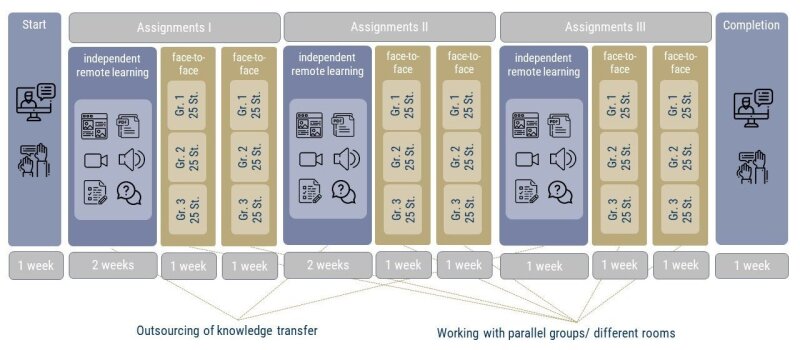
Overview
In this example, periods of independent online-learning and phases of in-person assisted working on tasks alternate. The acquisition of foundational knowledge takes place within the context of self-led remote learning. Here, students make use of audio-or screencasts or texts or scripts that the lecturer has provided them with.
Application of knowledge gained in such a way takes place during the in-person phase. Students work on practice tasks for which they need to draw on their self-study-acquired knowledge. The lecturer and – if applicable – tutors or peers accompany the process towards solving the tasks given. This takes place in accordance with the principle of minimal assistance, meaning that you give an impulse towards the solving process should it be required through the use of questions or specifically designed hints. The goal is to ignite the students’ quest for a solution without taking away from their process or providing solutions yourself.
An advantage of this teaching scenario lies in the fact that the lecturer is present where the need for them is often greatest: in the application of knowledge. Questions and lack of clarity often arise exactly when students begin working with new knowledge.
Start
- Takes place synchronously, depending on the size of the course via web conference (i.e. zoom) or in-person; duration: around 90 minutes
- all students participating in the course take part
- Determination of students’ level of knowledge and competence: e.g. assessing prior knowledge via an audience-response-system (e.g. pingoExternal link), a gathering of hypotheses or ideas on the topic of the course (e.g. tricider) or through creating an inventory of knowledge on a virtual pinboard (e.g. PadletExternal link)
- Introduction to different ways of working (course concept and structure); if applicable: preparation of dividing students into groups for the individual sessions
- Making students’ expectations transparent: which learning objectives are you pursuing in this course? How can/should all students participate? (When) should webcams/microphones be switched on during web conferences? How can technical difficulties be dealt with? What is due to be prepared for individual sessions? When, how, and on basis of which criteria is performance assessed and marked?
- Thematic introduction: Content schedule and central idea of the course; arouse interest in the topic, e.g. via usage of case studies/examples, through referencing your discipline’s challenges, making connections to students’ everyday environment; linking to and going beyond students’ points of prior knowledge e.a.
Assignment Packages I-III - In-person assisted working on tasks
- In our example each assignment package consists of a self-study period online plus in-person appointments with different groups each (with a maximum of 25 students per group). All students participating in the course are divided into three similarly sized groups.
- Independent online-learning period: students acquire new knowledge, actively digest it and/or solve problems; this process could be based on: recorded input, screencasts, self-study-videos, scripts, or texts.
- In-person group session: Students work on pre-assigned tasks (task packages), synchronously, and in-person. Duration of the sessions circa 90 mins, if applicable groups alternate weeks (see diagram); individual assistance during the process through the instructor(s) following the guiding principle of minimal assistance (see above). Goal: the application of knowledge and/or skills gained during self-study and/or practicing of discipline-specific practices as well as discussion of mistakes that hinder students’ further process.
- Organisational challenge: Each group needs a sufficiently spacious room (the number of participants in any given room needs to be in line with Covid-19-guidelines); therefore multiple rooms to work in and – if applicable – multiple instructors (and tutors if applicable) will be required, depending on the size of the group and the rooms.
Conclusion
- takes place synchronously via web conference (e.g. zoom) or in-person; duration: ca 90mins
- All students partaking in the course participate
- Thematic conclusion of the course, e.g. through a weaving together of the insights gained through the individual task packages
- Discussion of questions that have arisen across the different assignment packages
- Taking stock of acquired knowledge e.g. via mapping it out, for example with PadletExternal link)
- Tune in on upcoming assessments/exams: Sharing information on assessment modalities; giving insight into helpful exam preparation strategies and making the assessment criteria transparent; if applicable: Working on practice questions and subsequently clarifying questions arising during this process.
